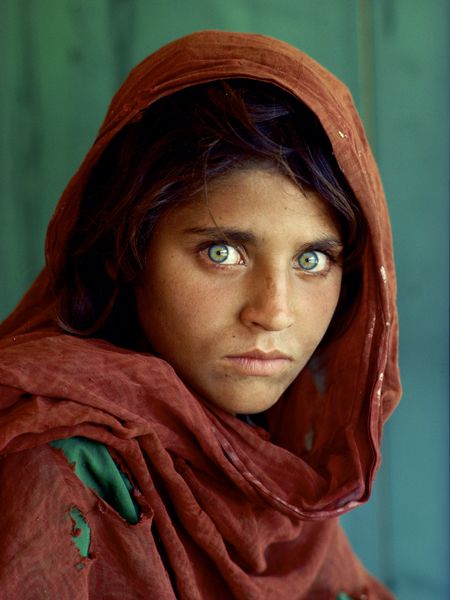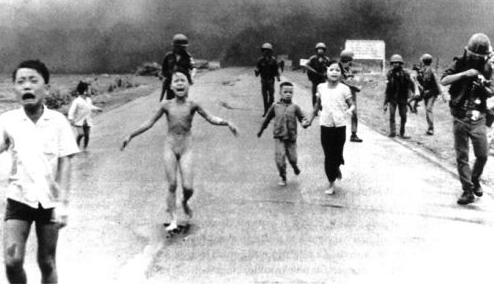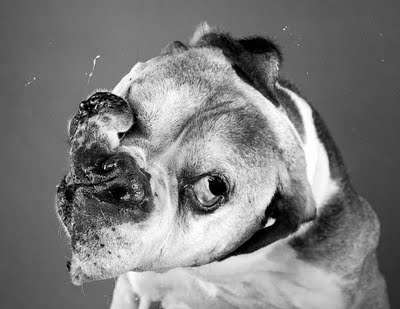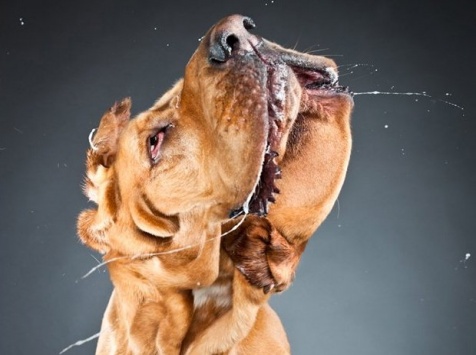Jonathan Knowles
Linder Sterling is another photomontage artist that often combined images taken from pornographic magazines with images from women's fashion and domestic magazines, particularly those of domestic appliances, making a point about the cultural expectations of women and the treatment of female body as a commodity.
One of her best-known pieces of visual art is the single cover for Orgasm Addict by Buzzcocks in 1977. It includes a collage of a iron-headed woman.
Bagrad Badalian
Link to The Whale Hunt website ------>
The Whale Hunt
Photography and Graphic Design
Examples of Photojournalism

In 1984, National Geographic photographer Steve McCurry took this girl’s photo. He found her at an informal school within a refugee camp in Pakistan. McCurry seized a rare opportunity to photograph Afghan women and so captured her image.
Although her name was not known, her picture, titled "Afghan Girl", appeared on the June 1985 cover of National Geographic. The image of her face, with a red scarf draped loosely over her head and with her piercing sea-green eyes staring directly into the camera, became a symbol both of the 1980s Afghan conflict and of the refugee situation worldwide. The image itself was named "the most recognized photograph" in the history of the magazine.
The identity of the Afghan Girl remained unknown for over 17 years. McCurry made several attempts during the 1990s to locate her, but was unsuccessful. In January 2002, a National Geographic team traveled to Afghanistan to locate the subject of the photograph and after a number of women falsely claimed themselves as the Afghan girl, they located her. Her name was Sharbat Gula
Afghan Girl photographed by Steve McCurry

Phan Thị Kim Phúc is a photograph taken during the Vietnam War in the 1972, by Nick Ut, a Associated Press (an American new agency) photographer.
The girl in the centre of this photograph is 9 year old Kim Phúc. She is running from a napalm attack, when South Vietnamese planes dropped a napalm bomb on a place called Trang Bang which had been attacked and occupied by North Vietnamese forces. A South Vietnamese pilot mistook the group of people to be enemy soldiers and attacked, causing two of Kim Phuc’s cousins to die. The bomb caused serious burns to Kim Phuc and it was unexpected that she would survive, but she did however after two years in care. The boy is her older brother. Both survived. Nick Ut earned a Pulitzer Prize for his photograph of the aftermath. It was also chosen as the World Press Photo of the Year for 1972. The image of Kim Phuc running naked amid the chaos became one of the most haunting images of the Vietnam War. In an interview many years later, she recalled she was yelling, Nóng quá, nóng quá ("too hot, too hot") in the picture.
Phan Thi Kim Phuc photographed by Nick Ut
Mallika Turilay
Examples of Photomontage
John Heartfield was a famous photomontage artist. As an anti-Nazi German he developed these photomontages to make political statements.
He changed his name to Heartfield from Helmut Herzfeld to criticise the anti-British sentiment in Germany at the time
One of the most famous is Hurrah, die Butter ist alle! (Hurrah, the butter is finished! 1935), showing a Nazi family, including the baby and dog, eating bicycle chains, hatchets, and other metal implements—a literal interpretation of Hermann Goering's dictum that ‘Iron makes a country strong; butter and lard only make people fat'.
Heartfield often used the image of Adolf Hitler and the Swastika in a satirical manner in his photomontages.
John Heartfield
A video on how they found her
Adolf the Superman: Swallows Gold and Spouts Junk
July 17, 1932
This piece was used as an anti-Hitler poster in the 1932 election. It refers to the financial backing Hitler received from wealthy industrialists who feared Germany would vote for a Communist government.
And yet it moves!
1943
This piece refers to a remark made by Galileo when he was forced to deny his belief that the Earth moved around the sun. Upon his release from the Inquisition, he stamped the Earth with his foot and said, "And yet it moves." This image shows that despite Hitler's terror, the world survived.
As in the Middle Ages...So in the Third Reich.
May 31, 1934
This piece shows humanity, broken on the wheel. It mirrors the traditional piece with a reference to the swastika, the Third Reich breaking human life.
Linder Sterling
Other Photographers
Carli Davidson
Carli Davidson is both an internationally recognized award winning photographer and an experienced animal trainer and caretaker. She is able to capture the innate personalities of her subjects using her professional understanding of animal behavior. She is a freelance photographer for the Oregon Zoo, and works regularly with domestic animals both commercially and personally for her fine art projects.
Carli spends much of her shoots rolling on the ground with her subject, getting in their skin as much as possible and encouraging them to open up to the camera. Her history working at the Oregon Zoo an well as nature preserves and animal rescues has given her the opportunity to care for everything from chimpanzees to rats. She shares her home with a dogue de Bordeaux named Norbert and a small, incredibly loud black cat named Yushi.
Her photography has been featured in national and international news publications, photography magazines, and websites, including the Vanity Fair, The New York Times, BBC, Huffington Post, The Daily Beast, Photo District News and ABC World News.


Jonathan Knowles is a London based photographer specializing in beautifully composed graphic still life, liquid and people photography.
His unique photographic style has earned him award winning, national and international advertising commissions working with advertising agencies worldwide.
In the past six years he has consistently featured in the ‘200 Best Advertising Photographers in the World’ books. He is now also one of the top 10 all time award winners in the Graphis Annuals, and has just had three images included in their volume ‘100 Best in Photography’, published in November 2011.
Lyndon Wade
The Wade Brothers are David Lindsey Wade and sibling Lyndon Wade who are each recognized as one of the top lifestyle, fashion and advertising photographers in the world. They have received worldwide acclaim and exposure for their work in all forms of media. Additionally their work appears in galleries around the world.
Development of CONTENT is the beginning of all communication. We imagine a sense of place and sensation, and create images and videos that tell a cohesive story whether for film or print.
Other uses of Photography
Jonathan Harris - The Whale Hunt
The Whale Hunt is an experiment in human storytelling.
In May 2007, I spent nine days living with a family of Inupiat Eskimos in Barrow, Alaska, the northernmost settlement in the United States. The first several days were spent in the village of Barrow, exploring ramshackle structures, buying gear, and otherwise helping the whaling crew to prepare for the hunt. We then traveled by snowmobile out onto the frozen Arctic Ocean, where we camped three miles from shore on thick pack ice, pitching our tents about ten feet from the open water. Boats were readied, harpoons prepared, whaling guns loaded, white tunics donned, a snow fence constructed, and then we sat silently in the -22 °F air, in constant daylight, waiting for whales to appear.
A thousand-year-old tradition, the Inupiat whale hunt provides the community’s annual food supply, currently limited by international law to 22 whales a year. Each spring as the ocean thaws, ice breaks away from the mainland as a single massive chunk, which then floats out to sea, creating a canal of open water called the "lead". It is through this lead that Bowhead whales migrate north to the Arctic Circle, where they spend summers, surfacing for air every 30-45 minutes en route. We saw hundreds of whales on the horizon, but most were too far away to attack. Finally on the fourth day two whales (each 36 feet long and weighing around 40 tons) were harpooned, hauled up onto the ice using a block and tackle system that resembles a giant tug of war between man and sea, and summarily butchered, the meat and blubber then distributed to the Barrow community.
I documented the entire experience with a plodding sequence of 3,214 photographs, beginning with the taxi ride to Newark airport, and ending with the butchering of the second whale, seven days later. The photographs were taken at five-minute intervals, even while sleeping (using a chronometer), establishing a constant “photographic heartbeat”. In moments of high adrenaline, this photographic heartbeat would quicken (to a maximum rate of 37 pictures in five minutes while the first whale was being cut up), mimicking the changing pace of my own heartbeat.